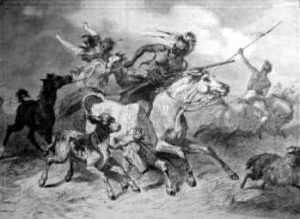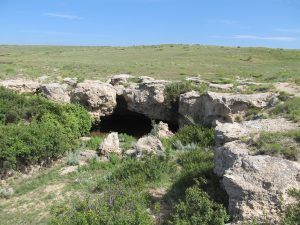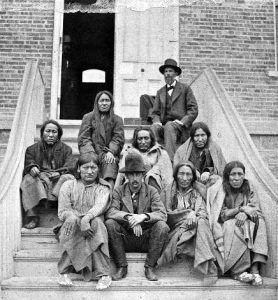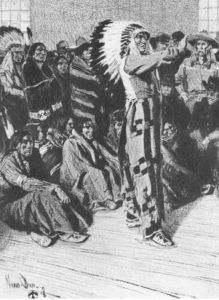When the last Indian tribes were removed from Kansas to the Indian Territory, hope was entertained that depredations on the western frontier would cease. But in September 1878, Dull Knife’s band of northern Cheyenne, dissatisfied with the terrible conditions and rations furnished by the government, decided to return to their former home in the Black Hills of South Dakota. They fled the reservation, moved northward into Kansas, and on September 17, attacked the cattle camps south of Fort Dodge, where they killed several white men and drove off some of the cattle. News of the event reached Governor George Anthony the next day, and he appealed to General John Pope, commanding the Department of Missouri for the U.S. Army, but Pope thought it was nothing more than a “scare.”
The governor sent Adjutant-General Peter Noble to Dodge City with arms and ammunition, but the Indians had moved northward. Lieutenant-Colonel William H. Lewis, with a detachment of troops from Fort Dodge, pursued the Indians and caught up with them at what is now called Battle Canyon on Punished Woman’s Fork in Scott County, Kansas.
On the afternoon of September 27th, Colonel Lewis and his troops advanced on the tribe from the southwest. The women, children, and elderly hid in Squaw’s Den Cave while the warriors fought the advancing soldiers. Lieutenant Colonel William H. Lewis was wounded in the thigh, and one warrior was killed. The following day, Lewis was placed in a military ambulance, and the soldiers made their way to Fort Wallace, Kansas, about 40 miles to the northwest. He died of his wounds along the way, becoming the last Kansas military casualty of the Indian Wars. The skirmish called the Battle of Punished Woman Fork, was the last Indian battle to occur in the Sunflower State. After escaping from Battle Canyon, the Indians made their way northwest.
After the skirmish, telegrams from various points in the western part of the state poured into the governor’s office appealing for aid, but still, General Pope declined to act.

Indian Raid
On September 30, the Cheyenne appeared in Decatur County near Oberlin, Kansas. When it became known that the Indians were in the county, a meeting was held, and several men volunteered to defend the area. They were divided into three small companies commanded by W. D. Street, J. W. Allen, and Solomon Rees. They went in different directions, scouring the western part of the county, but Captain Rees’ company was the only one that came in contact with the Indians. A running fight of several miles followed, in which one Indian was killed, and it was thought several others were wounded. Altogether, 17 white settlers were killed in Decatur County. The Indians were finally overpowered and returned to the reservation. This was the last Indian raid of any consequence in Kansas. In her book History of Kansas, Clara Hazelrigg said: “Of the many Indian raids in Kansas, none was ever characterized with such brutal and ferocious crimes, and none ever excited such horror and indignation as the Cheyenne raid of 1878.”
The Cheyenne then made their way to Nebraska, where they split up, with part of the group following Chief Dull Knife and the other with Little Wolf. Dull Knife’s group was captured close to Fort Robinson, Nebraska, while Little Wolf’s band remained in the sand hills of Nebraska for the winter and eventually made their way to Montana.
After the Fort Robinson Massacre in January 1879, Chief Wild Hog and six others surrendered and, on February 15, 1879, were taken first to Fort Leavenworth, Kansas, then to Dodge City for trial. They were finally tried in Ford and Douglas Counties, but the evidence was insufficient to convict. In October 1879, the Indians were released by order of Judge Stephens of Lawrence, Kansas.
After some delay, a reservation for the Northern Cheyenne was established in southeastern Montana near the Black Hills, the Northern Cheyenne Indian Reservation, and they were never forced to return to the South.
After the raid, the government established a cantonment in Indian Territory, on the north fork of the Canadian River between Fort Supply and Fort Reno, Oklahoma, to better protect the settlers in western Kansas. The post was occupied by five companies of foot soldiers and one company of mounted infantry. The state also took steps to afford security to the western settlements. Governor John St. John, who succeeded Anthony in January 1879, in his first message to the legislature, recommended the establishment of a military contingent fund, and on March 12, 1879, $20,000 was appropriated for the fund.
“Tell Him If He Tries To Send Us Back We Will Butcher Each Other With Our Own Knives.” — Dull Knife
©Kathy Alexander/Legends of America, September 2023.
Also See:
Fort Robinson Massacre, Nebraska




